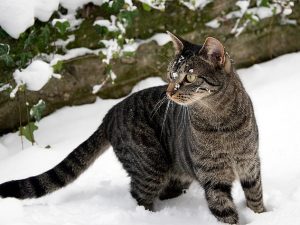
As the thermometer plunges and the days grow darker earlier and stay colder longer, there are entire colonies of cats that could not survive without the compassion and warmth of humans.
With North American winters becoming increasingly more severe, feral cats are faced daily with the terrible reality of either starving or freezing to death. But there are solutions, if members of the human community act humanely to provide the homeless cats in their neighborhoods with the shelter, food and water they lack and need.
In regions where snow falls and accumulates, blocking their usual safe places to live during the warmer months, these homeless cats’ “homes” virtually disappear. Offering them alternative places to live is both affordable and easy.
New or used doghouses provide the best protection as long as the opening is narrowed (6 to 8 inches is best) or covered with a flap to both keep out the elements and other roaming animals. Rubbermaid and Tupperware storage bins are two excellent alternatives, as are heavily insulated meat packing cartons – all with small openings carved into one side
For added warmth, insulation and comfort, place fresh straw (no clothing, which can stick to the cat’s body and freeze) on the floor. Straw helps to retain heat and repel moisture. Because cats will huddle together for warmth, provide a colony of cats with several shelters that can accommodate from three to five cats each. If caring for fewer cats, use a smaller shelter that requires less body heat to keep it warm.
Make certain to raise the shelters off the ground and situate them far from foot or street traffic in as quiet an area as possible. And after a snowfall, ensure that you shovel out the entrances to these shelters to prevent them from clogging up with snow and trapping the cats inside.
Food and water are the next in this trio of necessities. And because most feral cats are terrified of people, leaving some food near the entrances to the shelters will, by their scent alone, entice them close, closer, closest. Then, only a few paw prints away are their new winter homes.
Establish a “feeding station” NEAR each shelter to provide easy access for both you and the cats, then try to establish a regular schedule for feeding and water changing. The cats will quickly become accustomed to this routine while also growing accustomed to and less fearful of your approach.
Feed them larger than usual portions of easily digestible wet food, and on the coldest days, provide them with dry food as well, since the wet food can quickly freeze. But spraying insulation foam onto the underside of plastic dishes will help to keep the wet food from freezing at all. For water, use deep rather than shallow bowls and warm or hot rather than cold water. If possible, change the water twice a day, adding a pinch of sugar each time, to both keep it from freezing as quickly and to provide the cats with an extra energy boost.
And so, simply by acting humanely, we as caring communities can help those most helpless and vulnerable in our neighborhoods stay safe and stay alive this winter.
Article by Nomi Berger

